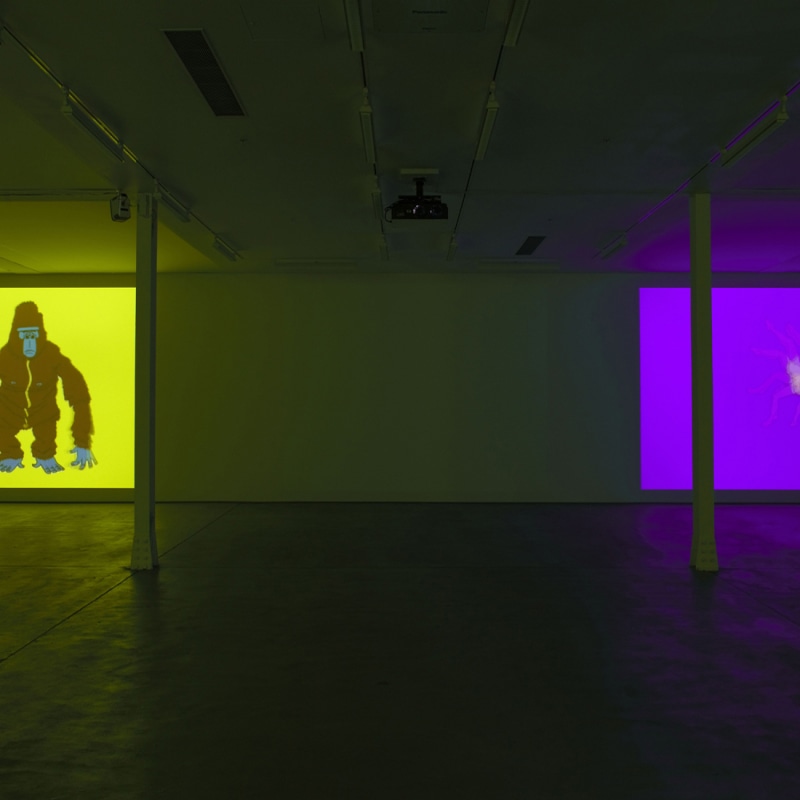From late February 2015, Sadie Coles HQ presents BODIES, an exhibition of animations by Angus Fairhurst. Beamed around the gallery in an immersive installation of up to eight projections, the works fall into five chronological chapters dating from 1995 to 2001.
This is the first exhibition dedicated to Fairhurst’s animations, a key thread in his early practice. Comprising a fourteen-minute cycle, the works trace the evolution of his distinctive iconography and tragicomic spirit. Hand-drawn gorillas and free-floating anatomies appear in repeating, uncanny gestures. Suspended on luminous fields of colour, they gyrate, morph, or snarl up indecipherably – setting in motion the imagery found in many of Fairhurst’s drawings, for which he used artists and various friends as his original models.
In Strange Loops – Stripping, 1995, we witness a gorilla endlessly peeling the skin away from a human figure to reveal another, identical skin. The action of going back to scratch, over and over, wryly evokes a world in which everything changes but nothing does. Strange Loops – Dissecting, 1996, from the same series, depicts a human figure in a gorilla suit splitting into anatomical cross-sections which dissolve, in turn, into patterned strata (akin to the abstract schemes found in a series of paintings of the same year) – a clunky cartoon rendering of figuration’s passage into abstraction.
In a corpus that resisted categorisation and traversed multiple media, animation and video occupied a central place. Produced using elementary software, Fairhurst’s animations often served as the backdrops to musical performances by his band Low Expectations, active between 1995 and 2001. In these, samples of music were repeated over and over and progressively superimposed, while the performers mimed in a parallel to the visual loops and overlaps. The animations are here presented on a correspondingly large scale that accentuates the contrast between the fitful vignettes and the bright, unchanging fields of colour against which they play out.
In the four-channel work Things That Don’t Work Properly / Things That Never Stop, 1998, corporeal fragments rotate and merge while conjoined pairs of legs perform aerobic sequences. The blue channel presents a swivel chair spinning to reveal a figure with alternating male and female genitals, before the rotation speeds up and the images superimpose to create a hermaphroditic jumble. A similar spectacle of alternating and intersecting genders reoccurs in Alternating, 2001, an eight-part piece in which cartoonish torsos, male and female, overlap and awkwardly mesh. Such abnormal anatomies and surreal hybrids appear throughout Fairhurst’s early animations and drawings. While looking back to surrealist bodily anagrams such as Hans Bellmer’s double-ended Dolls, or classical myths of dismemberment and metamorphosis, they also mass together to form a highly personal system of references. Their looping, listless actions encapsulate the double-edged mood of much of Fairhurst’s art – banal and melancholic, graceful and absurd.
Angus Fairhurst’s work is included in numerous major collections including that of Tate, which houses his archive of video and animation. One of the key members of the group of artists associated with London’s Goldsmiths College in the late 1980s, Fairhurst participated in the seminal exhibition Freeze (1988), which introduced the generation that became known as the Young British Artists, setting the tone for contemporary art in the UK over the following two decades. He graduated from Goldsmiths College in 1989. Following Freeze, he exhibited in key exhibitions – many of them featuring performance, video and animation – including Gambler (1991), Building One, London; Brilliant, Walker Art Centre, Minneapolis (1995); Some Went Mad, Some Ran Away, Serpentine Gallery (1994); Apocalypse, Royal Academy (2000 – an installation which centred on his animations); Casino 2001, SMAK, Ghent (2001; featuring the eight-part work Alternating, on view in the current show); and In-a-Gadda-da-Vida (with Sarah Lucas and Damien Hirst, Tate Britain (2004). Fairhurst had significant one-person exhibitions at Spacex Gallery, Exeter (2001), and Ursula Blickle Stiftung, Kraichtal, Germany and Kunsthalle St.Gallen. From 2009-11, a retrospective of his work travelled between Arnolfini, Bristol; Waddesdon Manor, Buckinghamshire; M Museum, Leuven, Belgium; and Westfälischer Kunstverein, Muenster, Germany. In 2010 and 2013, Sadie Coles HQ held exhibitions of his work, the former curated by Urs Fischer and Rebecca Warren. From 2013-14, his gorilla sculptures A Couple of Differences between Thinking and Feeling were on display in the City of London and NewArtCentre, Roche Court, Wiltshire and The Birth of Consistency were part of a solo presentation at Frieze Art Fair London.
For further information please contact the gallery at +44 (0)20 7493 8611 or press@sadiecoles.com

